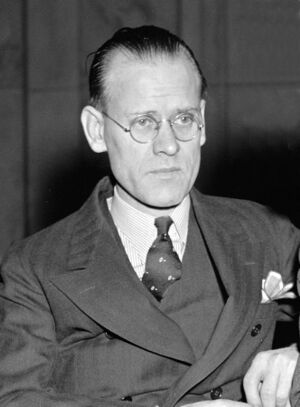Philo Farnsworth (nonfiction): Difference between revisions
| Line 26: | Line 26: | ||
== Fiction cross-reference == | == Fiction cross-reference == | ||
* [[Gnomon algorithm]] | |||
* [[Gnomon Chronicles]] | |||
== Nonfiction cross-reference == | == Nonfiction cross-reference == | ||
Latest revision as of 14:14, 19 August 2018
Philo Taylor Farnsworth (August 19, 1906 – March 11, 1971) was an American inventor and television pioneer. He made many contributions that were crucial to the early development of all-electronic television.
He is perhaps best known for his 1927 invention of the first fully functional all-electronic image pickup device (video camera tube), the "image dissector", as well as the first fully functional and complete all-electronic television system. He was also the first person to demonstrate such a system to the public.
On September 7, 1927, Farnsworth's image dissector camera tube transmitted its first image, a simple straight line, to a receiver in another room of his laboratory at 202 Green Street in San Francisco. His wife Pem recalled in 1985 that her husband broke the stunned silence of his lab assistants by saying, "There you are — electronic television!"
He first demonstrated his system to the press on September 3, 1928, and to the public at the Franklin Institute in Philadelphia on August 25, 1934.
In 1932, while in England to raise money for his legal battles with RCA, Farnsworth met with John Logie Baird, a Scottish inventor who had given the world's first public demonstration of a working television system in London in 1926, using an electro-mechanical imaging system, and who was seeking to develop electronic television receivers. Baird demonstrated his mechanical system for Farnsworth. Baird's company directors pursued a merger with Farnsworth, paying $50,000 to supply electronic television equipment and provide access to Farnsworth patents.
Farnsworth developed a television system complete with receiver and camera, which he produced commercially in the form of the Farnsworth Television and Radio Corporation, from 1938 to 1951, in Fort Wayne, Indiana.
In 1936, Farnsworth developed a process to sterilize milk using radio waves. He also invented a fog-penetrating beam for ships and airplanes.
Farnsworth Television and Radio Corporation was purchased by International Telephone and Telegraph (ITT) in 1951. During his time at ITT, Farnsworth worked in a basement laboratory known as "the cave" on Pontiac Street in Fort Wayne. From there he introduced a number of breakthrough concepts, including a defense early warning signal, submarine detection devices, radar calibration equipment and an infrared telescope.
In later life, Farnsworth invented a small nuclear fusion device, the Farnsworth–Hirsch fusor, or simply "fusor", employing inertial electrostatic confinement (IEC). Although not a practical device for generating nuclear energy, the fusor serves as a viable source of neutrons. The design of this device has been the acknowledged inspiration for other fusion approaches including the Polywell reactor concept in terms of a general approach to fusion design.
Farnsworth held 300 patents, mostly in radio and television.
In the News
1929: Math photographer Cantor Parabola takes retro-temporal pictures of inventor Philo Farnsworth demonstrating his electronic television system, revealing unexpected correspondences with other timelines.
Fiction cross-reference
Nonfiction cross-reference
External links:
- Philo Farnsworth @ Wikipedia

